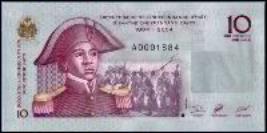Hyppolite is also credited with rebuilding Port-au-Prince, which had been ravaged by past revolutions and riots. He installed telephones, a domestic telegraph system, built the Marché en Fer (Iron Market), new wharves,
rebuilt the Chamber of Deputies, installed a water pumping station and the first ice plant in Port-Au-Prince.
President Hyppolite survived several coup and assassination attempts but died from an apoplexy attack near Léogane while riding his horse from Port-Au-Prince to
Jacmel.
In keeping with the design theme, the back of the 1,000 Gourdes banknote features the Marché Valière (Iron Market), with a scene that includes the ubiquitous “Tap Tap” trucks, which are often decorated with creative designs and Kreyòl sayings. Since the inauguration of the Iron Market on 22.11.1891 it has been central to commerce in Port-Au-Prince and a must see tourist stop. The back of the 1,000 Gourdes note also includes the De La Rue imprint and the date
1999.It now appears that the 1,000 Gourdes banknote will be issued sometime in 2004.
Although almost six months have passed since the start of Haïti's bicentennial, the series of six commemorating notes are also waiting for the same legislators to pass the law allowing their release to the public.
To commemorate its bicentennial on January 1, 2004, Daniel Elie was commissioned by the Central Bank, to create a series of six new banknotes. Each new design is implemented for the first time in bilingual French/Kreyòl text and dated 2004. These beautiful designs feature the most significant heroes of Haïtian independence and the first monuments to freedom, the
fortifications, which were instrumental in achieving victory over the French forces.
The 10 Gourdes features 23 year old Lieutenant Suzanne (Sanite) Belair, a heroic revolutionary woman. Sanite and her husband, General Charles Belair, nephew of Touissant L’Ouverture, lead valiant battles against French General, Charles LeClerc. Sanite and Charles were deceived by General Jean-Jacques Dessalines, Belair’s rival for power. “Charles Belair was a brave and intellectual black and favorite nephew of Touissant. He was inspired in his ambition by a courageous wife, Sanite. Fear of his ability
as a leader caused his betrayal.”(2) Dessalines captured the pair and turned them over to LeClerc. by General Jean-Jacques Dessalines, Belair’s rival for power. “Charles Belair was a brave and intellectual black and favorite nephew of Touissant. He was inspired in his ambition by a courageous wife, Sanite. Fear of his ability
as a leader caused his betrayal.”(2) Dessalines captured the pair and turned them over to LeClerc.
Although she was a freed person, Sanite had a deep hatred for the French slave masters and remained defiant towards her white captors until the end. After a war trial they were ordered to death. Her husband was to be shot and Sanite was to be decapitated. She insisted that
she be shot with her husband, even refusing to be blindfolded and they were executed together. Sanite is one of the true heroines of the revolution although she only reached the rank of Lieutenant, it is proper that she is honored along with the most revered revolutionary Generals.
The back of the 10 Gourdes depicts Fort Cap-Rouge in Jacmel.
<Previous Page | 1 | 2 | 3 | 4 | 5 | Next Page >
Home |
Catalog Index | Haiti Index | Articles | Links | Contact Us

©
Garry Saint, Esquire 1999-2004 All Rights Reserved |
